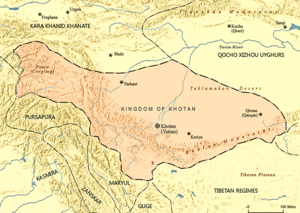Khotan
Jump to navigation
Jump to search
Khotan (C. Yutian 于闐) was an Indo-European oasis kingdom at the southern edge of the Taklamakhan Desert in Central Asia, along the northern slope of the Kunlun Mountains, "which served as a major center of Buddhism in Central Asia and an important conduit for the transmission of Buddhism from India to China."[1]
The Princeton Dictionary states:
- From at least the third through the tenth centuries CE, Khotan was a major Buddhist and trade center along the southern Silk Road through Central Asia, where Mahayana traditions associated with northwestern Indian Buddhism predominated. Indeed, through about the tenth century CE, Khotan was essentially a bastion of Indian urban culture in the Tarim Basin, which used Gāndhārī prakrit (in the Kharosthī script) in much of its written communications until the relatively late rise in the use of indigenous vernacular Khotanese (probably sometime after the sixth century CE).[1]
Notes
- ↑ 1.0 1.1 Robert E. Buswell Jr., Donald S. Lopez Jr., The Princeton Dictionary of Buddhism (Princeton: 2014), s.v. Khotan
Further reading
 Kingdom of Khotan, Wikipedia
Kingdom of Khotan, Wikipedia- Robert E. Buswell Jr., Donald S. Lopez Jr., The Princeton Dictionary of Buddhism (Princeton: 2014), s.v. Khotan
